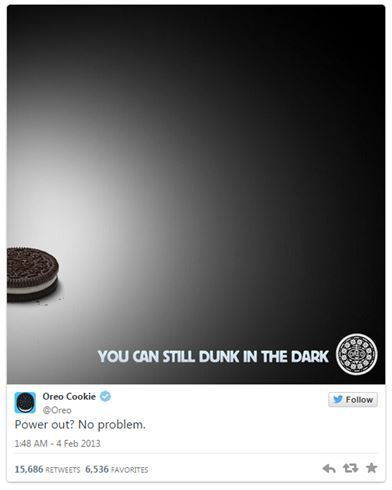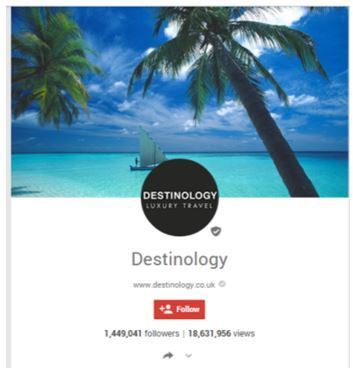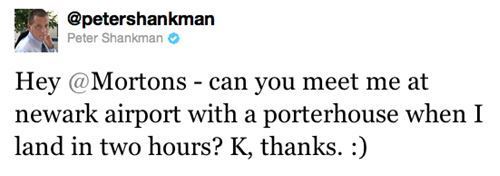Erik Qualman's Blog, page 578
November 20, 2014
Medical Community and Big Data Getting More Social

 While many people think of social media as just a means to connect to old friends, it’s actually much more.
While many people think of social media as just a means to connect to old friends, it’s actually much more.
Social media helps patients connect with others that may be suffering with the same disease, it allows doctors to relate to one another and it can help new and innovative ideas get funded.
Support Just a Tweet or Share Away
An example of just how powerful social media is was the earthquake in Haiti in 2010.
Most people heard about the damages and after-affects through social media, not through traditional media outlets like the news. Millions of people joined together to raise money and support to those who were affected by the earthquake. Facebook alone raised more than $100,000 to help the survivors.
This is just one incredible example of how social media is positively affecting the medical community and the world as a whole.
Social media affects people in smaller ways for the better, as well.
Assisting Medical Patients
Patients are now able to upload a photo of their injury and receive diagnosis from a real doctor. People can even “text a doctor” to get an immediate answer to a medical question.
Fun fact: Ninety percent of young patients ages 18-24 believe health information they receive through social media, according to Search Engine Watch.
Changes in the Healthcare Industry
Social media and technology are also changing the health care industry in many ways.
The article “How big data is transforming health care” discusses the more advanced ways that the health care industry is changing.
There are medical data streams (think the Netflix for medical instrumentation), quality of care analytics, telemedicine (which is similar to the texting mentioned above), medical imaging advancements and more. The author states that health care is one of the fastest growing sources of big data.
Social Media Positively Affecting Community
Social media in terms of the medical community is all about connecting and interacting with other patients, doctors, students, aides or anyone in the medical industry.
The internet is becoming more and more a place to interact and meet people and less of a place to just dump information. It’s about developing relationships with others, meeting new people and supporting good causes.
The top platforms on social media include Facebook, Twitter, Instagram, YouTube, Google+, LinkedIn and Pinterest. Whether you choose to get involved in all of them or one of them, you will be able to get connected with doctors, patients or other leading players in the medical industry.
From another point of view, hospitals and health care clinics are using social media, as well.
They are using it to brand themselves, provide valuable information to patients, get reviews and referrals, and provide information to those interested in different diseases and more.
Hospitals are even encouraging their staff to get involved with social media.
If social media is this big now (currently 1.73 billion people), one can only imagine how big it’s going to get.
It seems as though every industry is jumping on the bandwagon, including medical and health care.
Photo credit: Image courtesy of Stuart Miles at FreeDigitalPhotos.net
[image error]
4 Brands Who Are #Winning on Social Media

Social media is an increasingly important part of a brand strategy. As the transition from print to digital media continues, social media channels represent an opportunity for direct dialogue between brands and customers. If used in the right hands, it is an incredibly powerful tool: below are some brands who have their fingers on the social pulse and have seen great benefits as a result.
Oreo
These guys know exactly what they’re doing on social media – their finger is right on the pulse and enables them to make the most of situations that many other companies miss. The quick turnaround and punchy visuals during events like the infamous Superbowl XLVII blackout led to an estimated 280 million brand engagements, and led to them being more fondly remembered than brands who had paid millions of dollars for prized Superbowl ads.
As you can see, this tweet is flawless working proof of many business clichés: “short and sweet”, “a picture tells a thousand words”, “timing is everything”.
Perhaps more impressive is that this wasn’t a one-off. Oreo’s Daily Twist campaign featured one image every day for the brand’s centennial month, and performed equally as fantastically. Check it out for a good dose of social media inspiration.
British Airways
Another approach, taken by British Airways, is to be a source of information on all things relevant to your niche. By looking beyond the opportunity to promote only their brand, they have strengthened their position as authoritative voices in the travel niche (an accolade they held long before social media existed!).
Destinology
Also in the travel niche is Destinology, the luxury travel provider who command a following of over 1.3 million people on Google Plus – not too shabby! Lindsay, who works with Destinology, says that their focus is to tell a story with their social media pages, as you can’t sell a holiday without impactful visuals to show people what they’ll be experiencing. Understanding the behaviour of people online is vital for the success of Destinology: “people love to like, comment and share images that are striking and inspiring”.
Continuing the visual focus is Destinology’s recent introduction of virtual tours of their hotels. These were the result of working with Google Maps, and allow potential customers to explore numerous hotels in first person before booking. Gone are the days where you end up in a hotel not to your liking!
Morton’s Steakhouse
This tangentially continues the travel theme. As he was boarding a flight, Peter Shankman jokingly tweeted Morton’s Steakhouse asking if they could deliver a steak to the arrivals lounge.
He was obviously stunned when the brand responded and arranged for a tuxedo-clad man to deliver Peter a windfall of steak and sides, right there in arrivals. The subsequent publicity was huge, though controversial: many people said it was prearranged or that the brand wouldn’t have done it if Peter hadn’t had so many followers. Peter insists that it was genuine, and that the followers criticism is baseless. He says “customer service is no longer about telling people how great you are. It’s about producing amazing moments in time, and letting those moments become the focal point of how amazing you are, told not by you, but by the customer who you thrilled”
So what can we learn from this?
Timing is important. It’s not always possible (or prudent) to share to social media without planning and approval, but sometimes it can yield fantastic results.
Visuals are important. People behave in a very visual way on social media, and punchy visuals are guaranteed to capture attention and result in shares.
Knowledge is important. Positioning your brand as an influential and knowledgeable entity is difficult but, when achieved, hugely beneficial.
Experience is important. Nowadays, everyone has a voice online. Brands are no longer expected to broadcast how amazing they are, but to curate experiences that cause other people to do it for them.
[image error]
3 Reasons Snapchat’s Brand is in Jeopardy with Snapcash Feature

The dust has settled on Monday’s announcement from Snapchat about their new feature called Snapcash - a feature that connects your debit card to your Snapchat account sending money just as easy as sending a snap to your friend.
Even though the news is more than 72 hours old, the buzz on Twitter about Snapcash is certainly trending. Unfortunately for Snapchat, their brand is taking a hit. A big hit.
The question at stake right now for Snapchat, is “Was adding Snapcash the right move?” Time will tell, but for now, there are few telling signs that this might not be the latest feature that sticks with their 100+ million monthly users and effects their branding and more importantly their leadership.
Here’s why:
1. Security
Just five weeks ago in mid-October, Snapchat had 98,000 photos and videos hacked and posted online. Sure, Snapchat is claiming that all hacked content was from third party apps, but the perception is that Snapchat has been and is still viable for a hack.
The first thing that puts their branding and leadership in jeopardy, is to question why they would they release this feature a matter of weeks after this news broke. Type in Snapcash in Twitter search and thousands of tweets similar to Colin’s will appear (along with claims that people will be paying for nudes – that’s a whole other issue Snapchat needs to handle).
SnapCash seems like a great way to get hacked and taken for everything I own.
— Colin Huber (@CallOnColin) November 19, 2014
2. Arriving early to the party
Paying with your phone and transferring money on your smartphone is not new technology considering there are apps like Xoom, Cash, and Transferwise (and Paypal) out there already. Without a doubt, our society is headed into a more mainstream habit of replacing our wallet and cards for our phones. According to MarketWatch, more than 200,000 retailers have signed on to use ApplePay, Apple’s latest technology to late individuals pay with their phone. However, Snaptchat is not Apple. They are a messaging app (that in my opinion is killin’ it) with a majority of their users averaging 15-18 years old sending 700 million photos and videos per day. This target demographic is perfect and I’m sure Snapchat and Square (partner in Snapcash) are trying to capture them (early on might I add). However, is Snapchat going to educate teenagers how to be responsible with their money? (I doubt it).
This may be a sign of a misstep in Snapchat’s leadership while losing focus of why the app was created – to take photos, record videos, add text and drawings, and send them to a controlled list of friends or followers.
3. Digital voice is not helping their brand perception (or reputation)
Have you ever heard of Dollar Shave Club? A disruption for buying affordable razor cartridges for the everyday man (or college bro). They’re branding and voice is spot on to their target demographic. Just take a look at their first trailer and their recent commercial. Yes, it’s light hearted, fun, and what appears to be low-budget (even though it’s not).
Now let’s now look at Snapchat’s Snapcash commercial:
Would any of you trust your debit card with these clowns? Now, I’m not saying Snapchat can’t have some fun (after all their target demo is 15-18 year olds) but does this commercial convey security, reliable, and “sign me up”? So far, Snapchat’s “commercials” and Snapstories releasing new features have been young, organic, fresh, and by real people that make you want to update the app. This recent commercial is an over the top production that resembles Dollar Shave Club’s digital voice and misses the mark for their branding. Instead, they should have consider leaving out the “dancers and old monopoly man” inside your phone that literally are taking a percentage of your money and creating a Snapstory with real people in a real setting sending money to each other.
What are your thoughts on Snapchat’s new feature and the way they rolled it out? Would you use it or for the parents out there, let your kids use this new feature?
Thanks for reading. -Kevin
[image error]
November 19, 2014
5 Companies That Nail Social Media Recruiting

With big data recruiting on the rise, social media is playing more of a role in the hiring process than ever before. Industry leaders like Google, Facebook, Amazon and more are leading the charge towards a high-tech recruiting process, and social media is a big part of that strategy.
Social media recruiting is still a relatively new game, and some companies play it better than others. These 5 companies have used social media successfully to identify and hire top talent faster. Follow their lead, and stay on top of the latest trends in recruiting and hiring!
1. Twitter
It only makes sense that the company that revolutionized social media should be at the forefront of social media recruiting. With their highly innovative and successful recruiting initiative “Join the Flock,” Twitter effectively consolidated the lines of contact between serious, highly skilled job seekers and overworked headhunters. The @JoinTheFlock Twitter account has more than 406,000 followers, and tweets everything from open positions to recruiting events to positive posts from current Twitter employees.
2. Disney
Disney isn’t only the place where dreams come true – it’s also a champion of social media recruiting. The Walt Disney Company has a dedicated Twitter account (with more than 91,000 followers) for careers. The account posts descriptive job openings that make great use of hashtags (an example? “We’re on the lookout for an innovative #Marketing & Creative #Producer. Apply here! #disneyjobs”). It also posts tips for job seekers and recruiters, and links to Disney’s more robust careers page. The account even gives job seekers an inside look at famous Disney employees and today’s Disney culture.
3. Capital One
Capital One made its hiring campaign unique by using it to encourage other companies to improve their hiring processes as well. The initiative, called “Hiring 500,000 Heroes,” is also spearheaded by the U.S. Chamber Foundation and is designed to encourage companies to hire more veterans and military spouses. Capital One, which plans to hire at least 500,000 veterans of its own accord by the end of 2014, earned a ton of great PR and social media attention for the campaign.
4. Zappos
Zappos, the online shoe retailer, is well-known for its innovative recruiting strategies. Zappos exchanged conventional online job postings for their Inside Zappos page, designed to help applicants learn about Zappos’ culture and choose the area of the company that’s the right fit for them. The Inside Zappos page, along with Zappos’ robust social media accounts, gives potential candidates a more meaningful glimpse into what it would be like to work at Zappos’, and helps them find where they would fit in best.
5. Atlassian
Software company Atlassian is well known for its hiring initiatives, having gained notoriety for not one, but two different campaigns. The “Steal Your Geeks” and “The Atlassian 32” campaigns had different goals – the first attempted to recruit software developers from Europe, while the second tried to hire 32 engineers using nothing but social media. In both campaigns, Atlassian got rid of traditional recruiting methods and put 100% of their efforts into social media – and they increased their number of job applicants by more than 300%. Not only did the company tap into groups of passive job seekers that would otherwise go completely unnoticed, but it also branded itself as a tech-savvy company where young, fresh talent would love to work.
Social media recruiting isn’t just the future of human resources – it’s very much the present. If you’re looking to attract the youngest, freshest and best talent, you need to start recruiting on social media today.
Do you use social media to recruit? What companies do you think do it best?
[image error]
Buying Your Friends: The Pros and Cons of Purchasing Social Media Followers

 linkedmediagrp via Compfight cc
linkedmediagrp via Compfight cc
Most see “buying friends” as a bad thing. Why else would every sorority member who’s accused of buying her sisters’ friendship deny it so furiously? Yet in the marketing world, the stance isn’t always so clear.
If you’re facing the dilemma of whether or not to buy Twitter followers, Facebook Page likes, YouTube views or any other social media followers, consider these pros and cons:
Pro: You get more followers and high follower counts look impressive.
Twitter followers and Facebook Page likes are often called “vanity metrics” because they give a perceived popularity score. Even if those followers and purchased Likes don’t do anything else in terms of engagement, they can help a brand look more impressive to key stakeholders, including investors, partners and the end consumer. If vanity metrics are important, buying them is a fast way to grow those numbers.
Con: You’re likely to see decreases in engagement.
Purchased followers typically don’t engage with content, and based on Facebook’s April 2014 algorithm update, this could mean hurting the reach of your individual posts and causing your brand’s Page to lose positioning in the news feed. Purchased Twitter followers also skew metrics about the reach of your Tweets, as more followers suggest a higher reach even though those followers are not active.
Con: Purchased followers typically aren’t paid to stick around.
Buying followers to meet a quarterly goal has the potential to drop you into the vicious cycle of repeating the process quarter over quarter, as purchased followers begin to unfollow your brand (they didn’t have a compelling reason to follow you in the first place, after all).
Pro: It’s the only way to add followers on some social networks.
Unlike Twitter and Facebook, which allow you to use platform advertising to get your content in front of people from the start to grow the fan base, you must have more than 1,000 followers on Google+ before you can run +Post. Some might argue the only way for marketers with a small Google+ following to get in front of and grow a larger audience is to purchase those followers. This is less of a “Pro” and more of a justification. A little like saying, “Diet soda is a healthy option, because we don’t have regular soda.”
Con: Buying followers can be a violation of a social network’s TOS.
Each social network has its own terms of service (TOS), many of which include policies surrounding how followers and other key metrics can be attainted. YouTube, for instance, doesn’t count views from some third-party services, and trying to purchase views using one of those services could result in disciplinary action against an account, including the removal of the video or account suspension. Facebook also explicitly prohibits buying likes, stating: “If we detect that your Page is connected to this type of activity, we’ll place limits on your Page.” In other words, buy at your own risk.
Although buying Twitter followers, Facebook Page likes, YouTube views or any other social media followers can help your business achieve short term goals, it isn’t the strongest way to build a social media following. Genuine friends—the kind that vouch for you and want to spend time with you—can’t be bought; the same goes for social media followers.
[image error]
4 Ways to Turn Boring Data Into Captivating Content

Whatever industry you’re in, there’s a strong chance that you have quite a stash of data sitting around. And guess what–market and competitor research (and any other data you may have gathered) doesn’t have to be boring and can even add value to your customers. Turning data into captivating content is a great way to make it work twice as hard, giving you more bang for your buck.
To get started, think why the data you’ve collected could be interesting to your customers, then present it in a way that makes it easily digestible, shareable, and even fun. With a little know-how and a dash of creativity, your ‘boring data’ can become intrinsically engaging, just like some of the examples below.
Pay attention, and turn your boring data into content you can be proud of.
1. Turn Your Data into an Interactive Tool
Is salary by state inherently scintillating data? Not if you present it in a list. However, Rasmussen College managed to turn what could be thought of as ‘dry’ data into an interesting, and what’s more, useful, interactive tool.
By thinking about the value the data might have to the general public (wouldn’t you be interested to know if you could earn more doing the same job elsewhere?), then presenting it as a fun tool that users can engage with, they’ve added considerable value to their brand.
Takeaway: Useful content can boost audience engagement, making sure they stay on site longer. Think about your data’s value and present it in an easily digestible way.
2. Tour Your Users through History
Firestone’s recent visualization tells the fascinating story of America’s Giant Car Brands. They produced an interactive graph to display their ‘boring data’ alongside historical facts that make it interesting to an audience that otherwise might not have found it so.
By comparing their data with information that’s already in the public domain, they’ve discovered the story behind all those mind-numbing figures. Storytelling is huge news in content marketing—it can humanize a brand, making it seem more relatable and relevant in the real world, all fantastic news for the bottom line.
Takeaway: Think about the narrative behind your data. How can you explain it? Who might be interested in this story? Answer those questions, and you’ve got the beginnings of some brilliant content.
3. Bring a Little Fun to Your Data and Create a Game
If there’s one thing that most people can find time for when they go online, it’s to wind down by playing a game or two. With all this time spent playing, there’s hardly any left over for Internet users to become absorbed by the efforts of a hardworking marketer.
So what’s the answer? Blinkbox books turned their ‘boring data’ on reading averages into a game that tells readers how long it would take for them to finish Game of Thrones. By asking readers to read a quick passage and then answer a few questions on it, they deduce not only how many days it would take to read the entire collection (221, just saying…) but how this compares to the ‘average person’. Great fodder for showing off on social media, and Blinkbox ensure their users can do this easily. This is ‘boring data’ turned into excellent content – the kind that gets their audience to do their marketing for them.
Takeaway: Even if you haven’t got the budget for this nifty little game, try creating a microsite that allows your audience to compare themselves to your data. A little competition can be healthy in content marketing!
4. Got Geographical Data? Give an Interactive Map a Try!
Have you ever tried figuring out where and when you can get away for the weekend without breaking the bank? Entering the same information time and time again, only to give up and have that nice little pot of money get frittered away on clothes, takeaways and the odd concert ticket?
Kayak has turned the boring data that’s their bread and butter into an interactive map that makes that nightmare scenario a thing of the past. Thanks to them, users can now type in their local airport, choose a rough date and their options appear tantalizingly in front of them.
Takeaway: By figuring out what their customers want from their data, they’ve derived its true value and created something that is genuinely useful to their customers. If your content’s useful, it will get shared, driving up your traffic and also your sales.
The Takeaway
It’s all about value again here, but this time it’s about making your data more easily accessible. If your site is already data-driven, think about how best to present this data to your audience. Remember 70% of all our sensory receptors are in our eyes, and we can get a sense of a visual scene in less than one tenth of a second. Present your data visually to make it easily digestible and shareable.
Hopefully these 4 examples have convinced you that there’s no such thing as ‘boring data.’ Think about why your data’s relevant to your audience and you can come up with content as captivating as the brands above. Give it a try and let us know how it goes in the comments below!
[image error]
4 Companies Changing How We Communicate Online

Today’s technology moves so fast we rarely take a moment to step back and look at the impact on our lives. The way we communicate online is rapidly changing thanks to several key companies and their innovations.
In the post, I wanted to take a moment and recognize three companies that are playing an integral role in changing the way we communicate, and one company that I believe you’re going to see big things from in the future.
The Three You Know:
Snapchat
Snapchat is changing online communication by making it less permanent. Previously we understood that anything shared on the Internet would be there forever, but Snapchat changed that. What gets shared on Snapchat stays around for 24 hours at most, and a few seconds at the least.
Snapchat is helping us remember how to live in the moment. You don’t have to scrutinize everything shared on Snapchat because it’s only going to be there for a short while. The popularity of Snapchat has led to a number of similar apps hitting the marketplace, which makes me think this kind of communication is going to become more common online.
Reddit
Reddit is changing how we communicate by giving everyone the power to decide what goes viral online. Whether you realize it or not, much of the viral content you come across online originated on Reddit.
The reason why any piece of content gains visibility on Reddit is because of its users. Any user can submit content, and then any user can ‘up vote’ or ‘down vote’ it. The most up voted content rises to the top and gets seen by millions of people, while the down voted content gets buried to the far depths of the Internet.
The stuff that rises to the front page of Reddit spreads like wildfire, so Reddit users literally have the power to decide what’s popular online.
WhatsApp
WhatsApp amassed millions of users right under everyone’s nose, which was abruptly brought to the world’s attention when Facebook acquired the company this past February for an unprecedented $19 billion.
WhatsApp changes how we communicate online by putting the power of communication into the hands of more people. Being able to communicate with people across any device without incurring any charges is revolutionizing communication by giving millions of people the ability to communicate more freely.
What’s interesting to see is that companies like Jana and Hostt are using WhatsApp to communicate with their customer instead of regular chat. Apps like this are changing the way that we do business online.
One To Keep An Eye On
North Technologies
North Technologies is an app development company lead by Digg founder Kevin Rose. They recently released an ethereal photo sharing app called Tiiny, which is similar to Snapchat and may or may not turn out to be something revolutionary. That’s not why they’re on this list, the real reason to keep an eye on them is because of their business model.
North Technologies is comprised of Silicon Valley millionaires. They’ve made their money, and now they’re creating whatever they want because there’s no risk involved. If they create an app and it fails, it doesn’t matter. They’ll just move on to the next one, and I think they have the potential to create something that will change the way we communicate online.
Here’s how Rose explains it in an article on TechCrunch:
We can continue to try some wild and crazy stuff. Some will be slightly better takes on stuff.
Every page turn is going to be something completely different. We’re not going to do photo apps for ever. We’ve got ideas in the cryptocurrency space and there’s no common theme.
Are there any companies you would like to add to this list? Let me know in the comments section.
[image error]
Work on Being More Social in the Job Hunt

 Looking for a job is hard work.
Looking for a job is hard work.
Luckily, social media plays a big role in finding a job, and there’s a lot more to it than just the big names, like LinkedIn.
Yes, everyone in the workforce can probably benefit from a good LinkedIn profile and the connections accrued there, but it’s good to be aware of the some other job focused social media sites and even other information you can get from social media while searching.
If you’re in the job market, make sure you take a look at some of these sites:
Jobster – Jobster is a platform great for networking and job searching. You can find jobs in your area and your field, and network directly with those offering the job. You can post your resume, video resume and add links to any sites you have. Because it combines job search technology with social media for optimum matching, it’s a great tool to use when looking for a new position.
Google Plus – Many people forget Google Plus, even though it’s one of the biggies in the social media family. With Google Plus, you can learn valuable information about your field and where the hiring is happening, you can share your expertise and you can network and add colleagues and those in the industry to your page. A big advantage is that anyone who uses Google can come across your profile; you don’t have to be “friends” or “followers.”
Twitter – Recruiters are always scouring Twitter for great candidates. Make sure your profile is professional and your tweets are relevant to your career, not your social life. You can follow big names in the field and any companies you are interested in working for. You can learn of job openings and perhaps an insider’s view of what they’re really looking for.
Blogging – Many human resource professionals recommend blogging on your field. When you are in interview or sending in an application, it’s a great tool to get you noticed. Just make sure your blogs are relevant, current and accurate. You want to be able to showcase great work, not just some rant you created without much thought.
LinkedIn – Of course, LinkedIn is valuable, and there is a lot it can offer. Make sure your profile is current, your picture is professional and it doesn’t hurt to try to round up as many connections as you can. Some things matter more on LinkedIn than others, for instance, your friend’s endorsement may not be as credible as having a thorough description of your latest position.
Social Media Sites for Job Information
As the following article shows, you can learn a lot about job searching and other aspects of finding a job, like health insurance considerations for job seekers and negotiation topics.
LinkedIn offers great information on job searching, and you can also find valuable resources to follow on Twitter.
Look around for sites specific to your career or current needs and you may be very surprised at what leads and information you might come across.
Yes, job searching takes work.
It’s not the time to sit back and let things come to you – go get them.
And use social media to help you!
Photo credit: Image courtesy of Mister GC at FreeDigitalPhotos.net
[image error]
10 Startups That Have Changed Our Life

People are always excited to find new products, services, or online startups that make their lives even more convenient than they already are. There is a huge potential for companies that try to find us good shopping deals and great dates for our events, or connect us with more people in the online world. However, there are also some startups that seriously affect certain aspects of our lives. In the continuation, we will present the most innovative recent launches that really have the potential of changing our lives.
If you have never heard of Scoot Networks, then you’re in for a surprise: these are shared electric motor scooters that are activated by smartphones. The network is currently available in San Francisco, but the potential of this startup is much greater.
Space Monkey is a portable device where you can store all sorts of digital content and backup the data on an encrypted network. This startup offers much more storage than the popular Dropbox, costs only $10 per month and makes your data practically indestructible.
Amiigo shoe sensors and wristbands will track your movements, measure your heart rate and the levels of oxygen in your blood, and enable you to make a difference between your body’s performance in biking, swimming and running.
When you access MoviePass for a monthly fee of $30, you will be able to watch movies that are currently playing in theaters. Going to the movies is expensive, so MoviePass will save you a lot of money if you regularly go to the theaters. Plus, this startup saves you time as well. All you need to do is check in at the theater to activate the membership card and purchase your ticket at the box office or kiosk.
Women won’t understand how this startup can change a man’s life, but having access to high-quality razor cartridges at any time is of crucial importance. Dollar Shave Club enables you to choose one of three plans (that cost $1, $6 and $9 per month) and save hundreds of dollars on yearly basis.
BrainWritings has the potential of changing the way students perceive education nowadays. This is one of the projects that enable them to achieve their academic goals without giving up on their entire lives for the purpose of higher GPA. In essence, this website provides them with expert assistance in academic writing projects for a really affordable price.
Instead of going through the hassle and boredom of traveling alone, people can use this website to find friendly people to share rides with. All you need to do is insert your travel plans and the app will find you a match. You can offer a ride and share the expenses with a friendly person going your way, or you can request a ride while saving money and gaining great company at the same time.
How would you like your dishwasher to send you a tweet informing you that its work is finished? Believe it or not, this platform enables you to connect any electrical device to the Internet and get such updates. All you need to do is install a card with a built-in Wi-Fi antenna and smart processor that will help you make your home appliances more intelligent.
This is another ride-sharing service that makes your life more interesting and convenient. If you own a car, you can make some money by offering a ride to someone who needs it; and you can find an affordable solution if you’re a passenger who doesn’t like public transportation.
Help.Plagtracker is a web application created for providing editing services. It offers a free plagiarism checker tool which enables users to realize whether the paper they are checking is unique or not. An also, it offers editing service by highly professional writers for some payment.
More cool startups are coming your way!
It seems like people’s creativity can never be limited. We are always excited to see new apps, products and online platforms that diminish some of our worries. The ten startups listed above have different functions, but a common aim: to make our lives easier by providing effective solutions no one has ever thought of before.
[image error]
5 Businesses That Nail It with Their Web-Design
And it doesn’t matter what your business does: whether you sell water boilers or provide catering services, the design of your site should be up to the task – you cannot afford to treat it as something of little importance. Here are 5 businesses that certainly understand it.
1. Bee’s Wrap
Bee’s Wrap sells the least complicated thing imaginable – an alternative to plastic food wrap that uses ecologically safe ingredients, mostly paper and bee wax. It is a situation when excellent web-design is especially important – firstly, you have a single option to offer, which means that you can tailor the entire site to it (take notice of bee themes and olde-worlde stylization); secondly, you have to impress the visitor right away, showcasing your product – he isn’t going to stay due to the variety of products because there is no variety. And Bee’s Wrap pulls it off perfectly.
2. ExcelBuilders
Down-to-earth, serious businesses like house-building companies often consider it beneath themselves to prettify their websites – their management probably thinks that it is all child’s play and serious people should do business the old-fashioned way. ExcelBuilders is a an unexpected pleasure in this respect – their website looks modern, picturesque and professional – exactly what you would like to see in a company from which you buy a house to live in for years.
3. eKidsRooms
A crucial part of any web-design is to understand who the target audience of your website consists of. A miscalculation in this respect, and you can kiss your incomes goodbye. That is why before you even begin designing your site or giving instructions to the specialist you hired you should clearly understand who you want to attract, who is going to visit the site and what impression you want to create.
eKidsRooms is an excellent example of doing it right: bright colors, large, striking images, fonts that are at the same time rounded and childlike but still very much readable, consistent color palette throughout the site (blue, coral-red, green, brown) immediately let you see the nature of the place you visit.
4. FiftyThree
A company specializing in mobile applications is expected to have a beautifully designed site, and FiftyThree certainly lives up to expectations. Large animated images, high-quality photos showcasing the product from different angles, consistent gradient backgrounds, seamless transition between the elements – these guys clearly show that when it comes to design they know what they are doing. When you look at their products presented in such a manner you immediately want to have their product, even if you personally have nothing to do with drawing and sketching.
5. LuhseTea
There is nothing like a touch of individuality in design. There are many ways to achieve it, and one of them is to combine two themes that are not often brought close to each other and turn them into a core of your design.
Look at how it is done by LuhseTea – tea and Prohibition era are not the two things one immediately couples together. By combining them they make their site design striking and memorable, making sure that any visitor can find them again even if he forgets the exact name of the shop.
These sites show better than anything else that web-design isn’t a thing you can afford to neglect. The design of your site should be an integral part of the image projected by your company; in other words, it is an important tool to be used to its full potential.
[image error]











